| ________________
CM . . . . Volume XVII Number 34 . . . . May 6, 2011

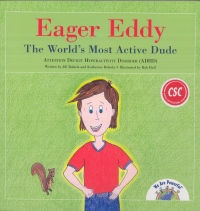 |
Eager Eddy: The World's Most Active Dude: Attention Deficit Hyperactivity Disorder (ADHD). (We Are Powerful Children's Book Series).
Jill Bobula & Katherine Bobula. Illustrated by Rob Hall.
Ottawa, ON: Wildberry Productions, 2007.
36 pp., pbk., $16.95.
ISBN 978-0-9784095-0-0.
Subject Heading:
Attention deficit hyperactivity disorder-Juvenile fiction.
Kindergarten-grade 4 / Ages 5-9.
Review by Charlotte Enns.
*** /4 |
| |
|
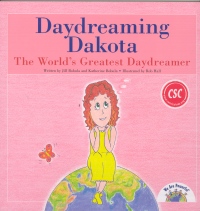 |
Daydreaming Dakota: The World's Greatest Daydreamer. (We Are Powerful Children's Book Series).
Jill Bobula & Katherine Bobula. Illustrated by Rob Hall.
Ottawa, ON: Wildberry Productions, 2008.
36 pp., pbk., $16.95.
ISBN 978-0-9784095-1-7.
Subject Heading:
Attention deficit hyperactivity disorder-Juvenile fiction. .
Kindergarten-grade 4 / Ages 5-9.
Review by Charlotte Enns.
*** /4 |
| |
|
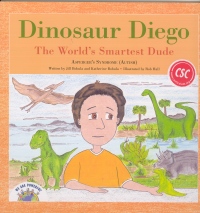 |
Dinosaur Diego: The World's Smartest Dude: Asperger's Syndrome (Autism). (We Are Powerful Children's Book Series).
Jill Bobula & Katherine Bobula. Illustrated by Rob Hall.
Ottawa, ON: Wildberry Productions, 2008.
36 pp., pbk., $16.95.
ISBN 978-0-9784095-6-2.
Subject Heading:
Atsperger's Syndrome-Juvenile fiction. .
Kindergarten-grade 4 / Ages 5-9.
Review by Charlotte Enns.
*** /4 |
| |
|
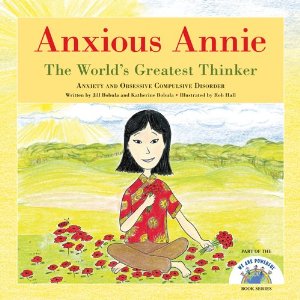 |
Anxious Annie: The World's Greatest Thinker: Anxiety and Obsessive Compulsive Disorder. (We Are Powerful Children's Book Series).
Jill Bobula & Katherine Bobula. Illustrated by Rob Hall.
Ottawa, ON: Wildberry Productions, 2009.
36 pp., pbk., $16.95.
ISBN 978-0-9784095-3-1.
Subject Heading:
Obsessive-compulsive disorder-Juvenile fiction.
Kindergarten-grade 4 / Ages 5-9.
Review by Charlotte Enns.
*** /4 |
| |
|
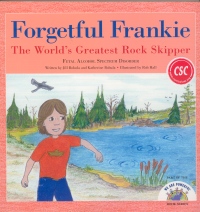 |
Forgetful Frankie: The World's Greatest Rock Skipper: Fetal Alcohol Spectrum Disorder. (We Are Powerful Children's Book Series).
Jill Bobula & Katherine Bobula. Illustrated by Rob Hall.
Ottawa, ON: Wildberry Productions, 2009.
36 pp., pbk., $16.95.
ISBN 978-0-9784095-4-8.
Subject Heading:
Fetal alcohol syndrome-Juvenile fiction.
Kindergarten-grade 4 / Ages 5-9.
Review by Charlotte Enns.
*** /4 |
| |
|
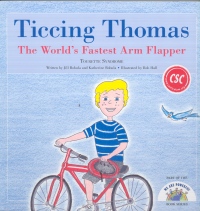 |
Ticcing Thomas: The World's Fastest Arm Flapper: Tourette Syndrome. (We Are Powerful Children's Book Series).
Jill Bobula & Katherine Bobula. Illustrated by Rob Hall.
Ottawa, ON: Wildberry Productions, 2009.
36 pp., pbk., $16.95.
ISBN 978-0-9784095-2-4.
Subject Heading:
Tourette syndrome-Juvenile fiction.
Kindergarten-grade 4 / Ages 5-9.
Review by Charlotte Enns.
*** /4 |
| |
|
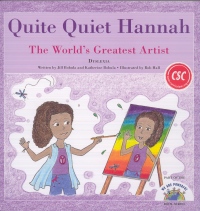 |
Quite Quiet Hannah: The World's Greatest Artist: Dyslexia. (We Are Powerful Children's Book Series).
Jill Bobula & Katherine Bobula. Illustrated by Rob Hall.
Ottawa, ON: Wildberry Productions, 2011.
36 pp., pbk., $16.95.
ISBN 978-0-9784095-5-5.
Subject Heading:
Dyslexia-Juvenile fiction.
Kindergarten-grade 4 / Ages 5-9.
Review by Charlotte Enns.
*** /4 |
| |
|

excerpt:
My name is Eddie and I'm the world's most active dude.
My name is Dakota and I'm the world's greatest daydreamer.
My name is Diego and I'm the world's smartest dude.
My name is Annie and I'm the world's greatest thinker.
My name is Frankie and I'm the world's greatest rock skipper.
My name is Thomas and I'm the world's greatest arm flapper.
My name is Hannah and I'm the world's greatest artist.
These quotes reflect the subtitles and opening lines of the characters featured in the seven books of the "We Are Powerful" series. According to the authors, the "We Are Powerful" children's books were conceived and designed to introduce the lives of children affected with different disorders and syndromes. 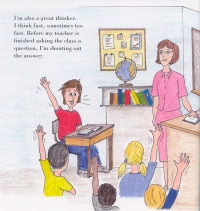 The purpose is to promote a better understanding of these conditions in children who are affected, as well as developing understanding, compassion and empathy among peers and educators. The series was created in response to the challenges that teachers face in including children with a range of disabilities into regular classrooms. The purpose is to promote a better understanding of these conditions in children who are affected, as well as developing understanding, compassion and empathy among peers and educators. The series was created in response to the challenges that teachers face in including children with a range of disabilities into regular classrooms.
The books are definitely focused on "teaching" and providing information and, in this way, fulfill their purpose. However, sometimes when the main focus of a story is to teach about a topic, particularly a sensitive topic where attitude change is the intended goal, the result can be the opposite. Rather than having a normalizing effect, the characters are singled out for being "special" or having a disability. On the other hand, when the main purpose is to tell an interesting story with characters who happen to have a disability, information about the disability can be incorporated into the natural flow of events. This is not the case for the "We Are Powerful" series – the books do not have stories with engaging plot lines or multi-faceted characters; they are specifically written to describe and educate others about the features of a central characters' disability.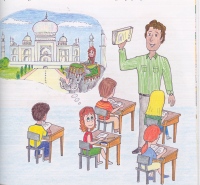
Each book in the series follows a similar formulaic structure. They always begin with the character who has a disability introducing themselves as the "world's greatest" at something and proceed to "what makes me so awesome." Although I understand the emphasis on abilities and positive language, I question whether this serves to normalize these characters, especially when they are highlighted for not having very valued abilities, for example, daydreaming or arm flapping.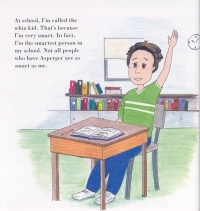 This is also why I do not think these books are appropriate for children beyond age 10, as children in middle years (grades 5 & 6) will see through this over-positive language. As people, we all possess both good and challenging qualities, and story characters need to reflect such an image in a more holistic and realistic way. Also, children can, and need to, understand that you do not need to be the "world's greatest" to still be able to make a contribution and be valued. In fact, I think much younger children can also understand these concepts, so wonder why these books do not present the characters in this way? This is also why I do not think these books are appropriate for children beyond age 10, as children in middle years (grades 5 & 6) will see through this over-positive language. As people, we all possess both good and challenging qualities, and story characters need to reflect such an image in a more holistic and realistic way. Also, children can, and need to, understand that you do not need to be the "world's greatest" to still be able to make a contribution and be valued. In fact, I think much younger children can also understand these concepts, so wonder why these books do not present the characters in this way?
I do want to be clear that the actual information about the children's disabilities and challenges they face, as well as the suggested strategies they and others can use, are accurate and excellent. 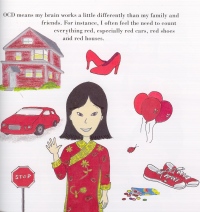 Using these stories will provide students and teachers with useful information and immediate ways for facilitating all students' participation in the classroom. I do like the fact that, throughout the books, the correct names of the disabilities are used, such as Attention Deficit Hyperactivity Disorder, Tourette's Syndrome, and so on. Each of these disabilities is then also described through experiences that children can relate to and in ways that are meaningful to them. Using these stories will provide students and teachers with useful information and immediate ways for facilitating all students' participation in the classroom. I do like the fact that, throughout the books, the correct names of the disabilities are used, such as Attention Deficit Hyperactivity Disorder, Tourette's Syndrome, and so on. Each of these disabilities is then also described through experiences that children can relate to and in ways that are meaningful to them.
Another feature of each story is the introduction of a peer or friend. Typically, these are described in their role as a "helper" to the child with a disability. 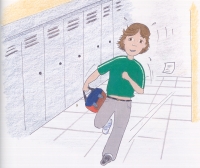 In each book, the friend is also someone with a similar disability. I think it is crucial to convey that children with disabilities are not alone and that others share their challenges; however, this portrayal also sends the message that children can only feel comfortable or be friends with people who can understand their disability firsthand. The stories would be strengthened by a broader message of acceptance and how, despite our differences, we can understand and share the same feelings. In each book, the friend is also someone with a similar disability. I think it is crucial to convey that children with disabilities are not alone and that others share their challenges; however, this portrayal also sends the message that children can only feel comfortable or be friends with people who can understand their disability firsthand. The stories would be strengthened by a broader message of acceptance and how, despite our differences, we can understand and share the same feelings.
The stories always end on a positive tone, with the child with the disability expressing genuine pride in who they are, and a clear acceptance of their disability, including the positive and challenging features.
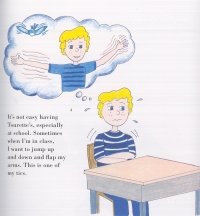
Overall, I would recommend the books in the "We Are Powerful" series for the purpose of teaching, but not necessarily for good reading. I would also narrow the age range from that indicated by the authors to children in the early elementary grades (K – 4). Children will also require some guidance in working through the information to ensure that they see the characters as people beyond simply the features of their disability. This includes understanding that the people they meet with disabilities may be very different from the characters in these stories. 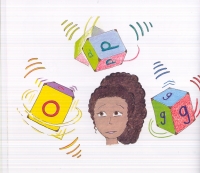 For example, not every child with dyslexia will be a talented artist or every child with Asperger's syndrome will be a dinosaur expert. For example, not every child with dyslexia will be a talented artist or every child with Asperger's syndrome will be a dinosaur expert.
Does the "We Are Powerful" series achieve its purpose? Yes, as a teaching tool and as a systematic way to introduce information about students with disabilities within a curricular context; however, it should be seen as a starting point. Students and teachers will need to go beyond simply reading these stories and extend their knowledge into other classroom/school practices in order to really have an impact on the successful inclusion of all children.
Recommended.
Charlotte Enns teaches in the area of Inclusive Special Education at the Faculty of Education, University of Manitoba and conducts research related to the literacy development of Deaf children.
 To comment
on this title or this review, send mail to cm@umanitoba.ca.
To comment
on this title or this review, send mail to cm@umanitoba.ca.
Copyright © the Manitoba Library Association. Reproduction for personal
use is permitted only if this copyright notice is maintained. Any
other reproduction is prohibited without permission.
NEXT REVIEW |
TABLE OF CONTENTS FOR THIS ISSUE
- May 6, 2011.
AUTHORS |
TITLES |
MEDIA REVIEWS |
PROFILES |
BACK ISSUES |
SEARCH |
CMARCHIVE |
HOME |







 The purpose is to promote a better understanding of these conditions in children who are affected, as well as developing understanding, compassion and empathy among peers and educators. The series was created in response to the challenges that teachers face in including children with a range of disabilities into regular classrooms.
The purpose is to promote a better understanding of these conditions in children who are affected, as well as developing understanding, compassion and empathy among peers and educators. The series was created in response to the challenges that teachers face in including children with a range of disabilities into regular classrooms.

 This is also why I do not think these books are appropriate for children beyond age 10, as children in middle years (grades 5 & 6) will see through this over-positive language. As people, we all possess both good and challenging qualities, and story characters need to reflect such an image in a more holistic and realistic way. Also, children can, and need to, understand that you do not need to be the "world's greatest" to still be able to make a contribution and be valued. In fact, I think much younger children can also understand these concepts, so wonder why these books do not present the characters in this way?
This is also why I do not think these books are appropriate for children beyond age 10, as children in middle years (grades 5 & 6) will see through this over-positive language. As people, we all possess both good and challenging qualities, and story characters need to reflect such an image in a more holistic and realistic way. Also, children can, and need to, understand that you do not need to be the "world's greatest" to still be able to make a contribution and be valued. In fact, I think much younger children can also understand these concepts, so wonder why these books do not present the characters in this way?
 Using these stories will provide students and teachers with useful information and immediate ways for facilitating all students' participation in the classroom. I do like the fact that, throughout the books, the correct names of the disabilities are used, such as Attention Deficit Hyperactivity Disorder, Tourette's Syndrome, and so on. Each of these disabilities is then also described through experiences that children can relate to and in ways that are meaningful to them.
Using these stories will provide students and teachers with useful information and immediate ways for facilitating all students' participation in the classroom. I do like the fact that, throughout the books, the correct names of the disabilities are used, such as Attention Deficit Hyperactivity Disorder, Tourette's Syndrome, and so on. Each of these disabilities is then also described through experiences that children can relate to and in ways that are meaningful to them.  In each book, the friend is also someone with a similar disability. I think it is crucial to convey that children with disabilities are not alone and that others share their challenges; however, this portrayal also sends the message that children can only feel comfortable or be friends with people who can understand their disability firsthand. The stories would be strengthened by a broader message of acceptance and how, despite our differences, we can understand and share the same feelings.
In each book, the friend is also someone with a similar disability. I think it is crucial to convey that children with disabilities are not alone and that others share their challenges; however, this portrayal also sends the message that children can only feel comfortable or be friends with people who can understand their disability firsthand. The stories would be strengthened by a broader message of acceptance and how, despite our differences, we can understand and share the same feelings.

 For example, not every child with dyslexia will be a talented artist or every child with Asperger's syndrome will be a dinosaur expert.
For example, not every child with dyslexia will be a talented artist or every child with Asperger's syndrome will be a dinosaur expert.